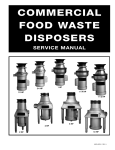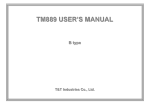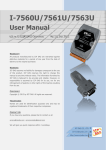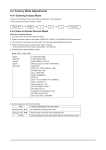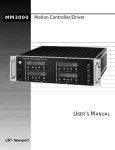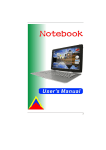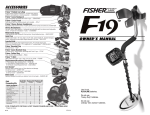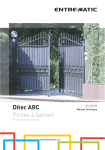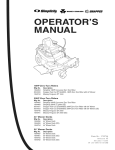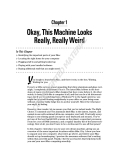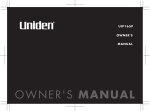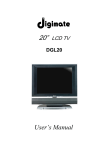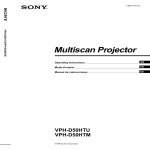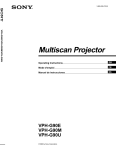Download OPERATING MANUAL
Transcript
5--YYEE AARR LLIIM 5 MIITTEED DW WAARRRRAANNTTYY The F2 metal detector is warranted against defects in materials and workmanship under normal use for five years from the date of purchase to the original owner. Damage due to neglect, accidental damage or misuse of this product is not covered under this warranty. Decisions regarding abuse or misuse of the detector are made solely at the discretion of the manufacturer. Proof of Purchase is required make a claim under this warranty. Liability under this Warranty is limited to replacing or repairing, at our option, the metal detector returned, shipping cost prepaid to Fisher Labs. Shipping cost to Fisher Labs is the responsibility of the consumer. To return your detector for service, please first contact Fisher Labs for a Return Authorization (RA) Number. Reference the RA number on your package and return the detector within 15 days of calling to: OPERATING MANUAL Fisher Labs 1465-H Henry Brennan Dr. El Paso, TX 79936 Phone: 915-225-0333 ext.118 Warranty coverage does not include the cost of transporting the detector back to an owner who is located outside of the United States of America. Copyright© 2007 All rights reserved, including the right to reproduce this book, or parts thereof, in any form. Fisher® is a registered trademark of Fisher Research Labs www.fisherlab.com 1465-H Henry Brennan, El Paso, TX 79936 • (915) 225-0333 LINE A K AL LY Use ries ON e Batt TABLE OF CONTENTS SSe e ttttiinngg UU pp . . . . . . . . . . . . . . . . . . . . . . . . . . . . . . . . . . . . . . .33 Baatttteerrii eess . . . . . . . . . . . . . . . . . . . . . . . . . . . . . . . . . . . . . . . . .44 B Hee aaddpphhoonnee JJaacckk .. .. .. .. .. .. .. .. .. .. .. .. .. .. .. .. .. .. .. .. .. .. .. .. .. .. .. .. .. .. .. .. ..44 H Quuiicckk--SSttaarr tt DDeem Q moo . . . . . . . . . . . . . . . . . . . . . . . . . . . . . . .55--66 Coonnttrr ooll PPaanneell .. .. .. .. .. .. .. .. .. .. .. .. .. .. .. .. .. .. .. .. .. .. .. .. .. .. .. .. .. .. .. .. .. .. ..77--99 C SS e ennssiittiivviittyy .. .. .. .. .. .. .. .. .. .. .. .. .. .. .. .. .. .. .. .. .. .. .. .. .. .. .. .. .. .. .. .. .. .. .. ..77 D iissccrrii m D miinnaattiioonn C Coo nnttrrooll .. .. .. .. .. .. .. .. .. .. .. .. .. .. .. .. .. .. .. .. .. .. .. .. ..88 Piinnppooiinntt .. .. .. .. .. .. .. .. .. .. .. .. .. .. .. .. .. .. .. .. .. .. .. .. .. .. .. .. .. .. .. .. .. .. .. .. ..99 P N oottcchh .. .. .. .. .. .. .. .. .. .. .. .. .. .. .. .. .. .. .. .. .. .. .. .. .. .. .. .. .. .. .. .. .. .. .. .. .. .. ..99 N 4--TToo nnee AAuuddiioo SSyysstteem 4 m .. .. .. .. .. .. .. .. .. .. .. .. .. .. .. .. .. .. .. .. .. .. .. .. .. .. .. .. .. 1100 Deepptthh aanndd TTaarrggee tt DDiissppllaayy .. .. .. .. .. .. .. .. .. .. .. .. .. .. .. .. .. .. .. .. .. ..1111--1122 D TTa arrgg eett RRee aaddoouutt TTaabbllee .. .. .. .. .. .. .. .. .. .. .. .. .. .. .. .. .. .. .. .. .. .. .. .. 1122 SSe e nnss iittii vviittyy AAddjj uuss ttm m eenntt . . . . . . . . . . . . . . . . . . . . . . . . . . . . .1133 Ell eeccttrr oom E maaggnneettiicc IInntteerr ffeerr eennccee .. .. .. .. .. .. .. .. .. .. .. .. .. .. .. .. .. 1133 SS e evveerr ee G Grroouunndd C Coonnddiittiioonnss .. .. .. .. .. .. .. .. .. .. .. .. .. .. .. .. .. .. .. .. 1133 TARGET PINPOINTING (no-motion PINPOINT mode) After you have identified a target using a motion mode of detection, press to identify the target’s exact location. This technique can yield more information about the target’s shape and size and also find its exact location to facilitate excavation. UUssiinngg :: 11.. Position the searchcoil just barely off the ground, and to the side of the target. 22.. Press and hold and raise the searchcoil about 2 inches. Lifting the searchcoil away from the ground makes the ground signal go negative, so the machine is silent. 33.. Now move the searchcoil slowly across the target, and you can locate it by the sound. The target is located directly under where the sound is loudest. NN aarrrroow w IItt DDoow wnn :: 11.. To narrow the response further, position the center of the searchcoil near the center of the response pattern, but not directly over the center. 22.. Release, then press and hold again again. 3.. Repeat this narrowing procedure to narrow the 3 field of detection further. NNoottee :: Depth indication is less accurate after narrowing. COIL DRIFT If you keep depressed for continuous searching, realize that drift will occur over time, causing the detector to gain or lose sensitivity. Periodic retuning of the detector is required to minimize drift; release and press to retune. SSe e aarrcchh TTeecchhnniiqquueess . . . . . . . . . . . . . . . . . . . . . . . . . . . . . . .1144 TTa arrggeett VVeerr iiffiiccaattiioonn .. .. .. .. .. .. .. .. .. .. .. .. .. .. .. .. .. .. .. .. .. .. .. .. .. .. .. 1144 Piinnppoo iinnttiinngg w P wiitthh m moottiioonn m m ooddee ss .. .. .. .. .. .. .. .. .. .. .. .. .. .. .. .. 1144 TTaarrgg eett PPiinnppooiinnttiinngg ((NN oo m moo ttiioo nn)) . . . . . . . . . . . . . . . . . . . . .1155 Co C oiill DDrriiff tt .. .. .. .. .. .. .. .. .. .. .. .. .. .. .. .. .. .. .. .. .. .. .. .. .. .. .. .. .. .. .. .. .. .. .. .. .. .. .. .. 1100 2 2 155 1 SEARCH TECHNIQUES (in DISC mode) TTa a rrggeett VV eerrii ffiiccaa ttiioonn After detecting a target, do the following: WRONG 11.. Walk around the target in a circle. 22.. While circling the target, continue sweeping the searchcoil across the target. 33.. Sweep once every 30° or 40° of CORRECT the circle. If the tone does not change and the target ID value is consistent as you circle the target, you can be highly confident of the target’s identification. If the tone or target ID COIL MOVEMENT changes as you circle the When swinging the coil, be target, you may have multiple careful to keep it level with the ground about 1/2 inch targets or an irregularly shaped from the surface. Never swing object. the coil like a pendulum. If the tone completely disappears at different angles, the target may be trash or a low-value metal. If you are new to the hobby, dig all targets. With practice in the field, you will soon identify audible and visual target feedback with certain types of metal objects. Pii nnppooii nntt iinn gg iinn m P m oottiioonn ((nn oott ppiinn ppooii nntt)) m mooddee:: 11.. 22.. 33.. 44.. 55.. Sweep over target in narrowing side-to-side pattern Take visual note of spot on ground where “beep” occurs. Step 90° to the side of the target Sweep coil over same area, at 90° to 1st sweep pattern. This pinpoints the target location with an “X” SETTING UP No tools required. 1 Insert the lower stem (plastic tube) into the 1 l middle stem. 2 Position the lower stem with the silver 2 l button toward the back. Using the bolt and knurled knob, attach the search coil to the lower stem. 3 Press the button on 3 l the middle stem, and slide the lower/middle stem assembly into the upper s-shaped stem. Middle Stem Locking Collar Knurled Knob Searchoil Adjust the stem to a length that lets you maintain a comfortable upright posture, with your arm relaxed at your side, and the search coil parallel to the ground in front of you. 4 Wind the cable securely around the stems. 4 l 5 Insert the plug into the matching connector on the right underside of 5 l the detector body. Be sure that the key-way and pins line up correctly. 6 After the stem length is adjusted to your height, tighten the two 6 l locking collars to stabilize the stems. Arm Rest Adjustment If you wish to change the position of the arm rest, remove the screw and move the arm rest to one of the alternate hole locations. Caution: Do not force the plug in. Excess force will cause damage. To disconnect the cable, pull on the plug. Do not pull on the cable. 144 1 3 3 BATTERIES TTw woo 99--VVoolltt bbaattttee rrii eess aarr ee ss u uppppll iiee dd w wiitthh tthhee FF22 .. The batteries have been inserted backwards in the compartment for storage during transportation. Please remove batteries, turn them around, and install correctly. Use A ALLKKAALLIINNEE batteries only. DDoo nnoott m m iixx oolldd aanndd nnee w w bbaatt tteerriieess.. 1 Remove the battery cover by 1 l disengaging the clip at the back. To install the batteries: Doo nnoott hhiinnggee ddoooorr uuppw D w aarrdd ; pull straight back 2 Align the polarity of the batteries correctly, with the positive "+" 2 l toward the coil plug connection, as indicated by the + indicator 3 Insert (2) 9-Volt AA LLKKAA LLIINNEE batteries, with the contacts pointed inward, 3 l and press down on the back of the batteries to snap them into place. on the housing. Some brands of batteries will require moderate force to clear the retaining tabs. 4 Replace the battery door. 4 l Most metal detector problems are due to improperly installed hee batteries, or the use of non-alkaline or discharged batteries. II ff tth ddee ttee cctt oorr ddooee ss nnoott tt uurrnn oonn,, ppll eeaassee cchh eecc kk tt hhee bbaatt ttee rriiee ss.. USING HEADPHONES Using headphones (not supplied) improves battery life, and prevents the sounds from annoying bystanders. It also allows you to hear subtle changes in the sound more clearly, particularly if searching in a noisy location. For safety reasons, do not use headphones near traffic or where other dangers are present. This device is to be used with interconnecting cables/headphone cables shorter than three meters. 44 SENSITIVITY ADJUSTMENT ELECTROMAGNETIC INTERFERENCE Use the Sensitivity Control is to eliminate Electromagnetic Interference (EMI). The F2 metal detector is an extremely sensitive device; the search coil creates its own magnetic field and acts like an antenna. If your detector beeps erratically when the search coil is motionless, the unit is probably detecting another electromagnetic field. Common sources of EMI are electric power lines, both suspended and buried, motors, and household appliances like computers and microwave ovens. Some indoor electronic devices, such as dimmer switches used on household lighting, produce severe EMI and can cause the detector to beep erratically. Other metal detectors also produce their own electromagnetic fields; so if detecting with a friend, keep two metal detectors at least 20 feet apart. R EE DDUUCC EE TTHH EE SS EENNSS II TTII VV IITTYY by pressing the If the detector beeps erratically, R SS eenn ss iitt ii vvii tt yy Pad on the left of the control panel. In most urban environments, you should be able to search without chatter from interference at the default sensitivity setting (default setting is the sensitivity level at power-up, 4 bars), or at one level reduced from default. At maximum sensitivity, the F2 will “chatter” in proximity to underground or overhead power lines, or to indoor or outdoor electrical devices. In fact, if you notice rapid chatter with the searchcoil near the ground, you may be able to trace the approximate location of the underground power lines by following the chatter. To manage chatter, which is most likely from electrical interference: 11.. R R EE DDUU CC EE tt hh ee SS EE NNSS II TT IIVV II TT YY until the chatter stops. 22.. Try sweeping it over the ground. If the F2 chatters while held still, or held up in the air, it may be much quieter when sweeping over the ground. SEVERE GROUND CONDITIONS A secondary use for the Sensitivity Control is to reduce false detection signals caused by severe ground conditions. While the detector contains circuitry to eliminate the signals caused by most naturally occurring ground minerals, 100% of all ground conditions cannot be anticipated. Highly magnetic soils found in mountainous and gold-prospecting locations can cause the detector to emit tones when metal objects are not present. High saline content soils and sands can sometimes cause the detector to beep when no metal target is present. If the detector emits false, non-repeatable, signals, REDUCE THE SENSITIVITY. 133 1 DEPTH AND TARGET DISPLAY QUICK-START DEMONSTRATION DDIIM MEE:: Dimes and pre-1982 pennies will register here. Older, pre-1982, pennies are composed of copper, which has a metallic signature similar to a dime. Most copper coins will register here. Steel washers, with an outside diameter similar to a dime, may also register here. II.. SSu uppppllii eess NN ee eeddee dd • A Nail • A Zinc Penny (dated after 1982) QTTR Q R:: Quarters, “Sacawegea Quarters” & “Susan Q. Anthony Dollars” register here. + + :: Half-Dollar coins and Silver Dollars register here. Very large iron objects like Sewer Lids will also register here. CC aa uutt iioo nn :: The target indications are visual references. Many other types of metal can fall under any one of these categories. While the F2 will eliminate or indicate the presence of most common trash items, it is impossible to accurately classify ALL buried objects. DEPTH INDICATOR: (in pinpoint mode) The Depth Indicator is calibrated to coin-sized objects. It indicates the depth of the target, in inches. Large and irregularly-shaped objects will yield less reliable depth readings When passing over an object, the depth indicator will light up and stay illuminated while an object is in the field of detection. the depth indicates the distance, in inches from the center of the search coil to the target. 2 DIGIT TARGET INDICATOR The 2-digit target indicator, in the middle of the LCD display, provides a specific target value to help identify buried targets more accurately. With practice in the field, you will learn to associate target values with the probable identification of buried objects. The target value can vary each time the coil passes over the target, depending upon the angle of the object and the distance from the coil. AAss aa ss ttaarrtt iinngg ppooii nntt ,, rreeff eerr ttoo tt hhee tt aabbllee bb eellooww .. TTA ARRG GEETT RReeaaddoouutt The table below lists some common approximate target value equivalents. With experience in the field, you will recognize many types of metals by their numeric value. TT YYPPIICCAALL VVAALLUUEE 0-15 25-28 28-32 36-42 58-62 68-72 78-83 86-90 91-95 122 1 PPO OSSSSIIBBLL EE O OBB JJEE C CTT SS Iron Pull-Tab Tail (broken off) Nickel Pull-Tab (old type) Zinc, Penny Dime & Wheat Cent Quarter Half Dollar Silver Dollar • A Quarter • A Nickel IIII.. P Po ossiitt iioonn tthhee DD eett eecc ttoorr a. Place the detector on a table, with the search coil hanging over the edge. (or better, have a friend hold the detector, with the coil off the ground). b. Keep the searchcoil away from walls, floors, and metal objects. c. Remove watches, rings and other jewelry or metal objects from hands and wrists. d. Turn off appliances or lights that cause electromagnetic interference. e. Pivot the search coil back toward the detector body. IIIIII .. P Poow wee rr UUpp Press . IIV V.. W Wa avvee eeaacc hh O Obbjjeecc tt oovvee rr tt hhee SSee aarrcc hh C Cooiill a.Notice a different tone for each object. Nail LLoow w TTo on ne e:: LLoow wM M iid d TTo on ne e :: Nickel Me M ed diiu um m TTo on ne e:: Zinc Penny HHiigghh TT oonn ee :: Quarter b.Motion is required. Objects must be in motion over the search coil to be detected. V.. PPrreess ss DDIISS CCRRIIMMIINN AATTIIOONN Twice V a. The first press illuminates all target icons. b. The second press turns off the “IRON” icon. Quick-Start Demo continued on next page 5 5 QUICK-START DEMONSTRATION VII.. W V Wa avvee tt hhee NN aaiill oovveerr tt hhee SSee aarrcchh C Cooiill a. The Nail will not be detected. b. The Nail has been "Discriminated Out." VIIII .. PPrree ssss DD IISSC V CRRII M MIINNAA TTIIO ONN 55 ttiim me ess.. Only the Dime, Quarter and + icons will remain illuminated. VIIII II.. W V Wa avvee aallll oobbjjee cctt ss oovveerr tthhee SSeeaarrcc hh C C ooiill The Nail, Nickel and Penny will not be detected. The quarter will be detected with a high tone. IIX X.. • Press NOTCH • Immediately press DISCRIMINATION • Press NOTCH again • The “Nickel” icon is again illuminated. • You have “Notched In” the nickel X.. W X Wa avvee tthhee nniicc kkeell oovveerr tt hhee sseeaarrcc hh cc ooiill.. The nickel is detected. XII.. PPrreessss aanndd hhoolldd PPII NNPPO X OIINNTT.. Hold a coin motionless over the search coil. • All Metal objects are now detected. • One monotone sound indicates the presence of any type of metal. • Depth is indicated in inches. Move a coin toward & away from the search coin. Watch the depth indicator change. (continued) DEPTH AND TARGET DISPLAY READING THE DISPLAY The Liquid Crystal Display (LCD) shows the PROBABLE identification of the targeted metal, as well as the PROBABLE depth of the target, in inches. An arrow will illuminate under the target category where an object is best classified, and stay illuminated until another target is identified. The detector will normally register a repeating, unchanging target identification when a buried target has been located and identified. If, upon repeated passes over the same spot, the target identification reads inconsistently, the target is probably a trash item, oxidized metal, or too deep to be classified accurately. With practice, you will learn to unearth only the more repeatable signals. The segment identifications are highly accurate, when detecting the objects described on the label. However, if you register in a given category for an unknown buried object, you could be detecting a metallic object other than the object described on the label, but with the same metallic signature. Also, the greater the distance between the target and the coil, the less accurate the target identification. Me M ed d iiu um m--ss iizze edd ggoolldd iitteem m ss will register under Nickel or Tab. LLaa rrggee ggoo lldd iitteem m ss will register under Tab or Zinc. SS IILLVV EERR TTAARR G GEETTSS :: Silver objects will normally register to the right of the +, scale, under Dime, Qtr, or + depending on the size of the object. The larger the object, the farther to the right it will register. IIRRO ON N:: Ferrous objects will register on the far-left side of the target identification scale. Objects in this category could be worthless scrap, or a more valuable iron relic. FFO OIILL:: Small pieces of aluminum foil, like gum wrappers, will register here. NNIICC KKEELL:: Nickels and most newer pulltabs(those that stay attached to the can) will register here. TTAABB:: Pull-tabs from older beverage cans will register here. Few newer pulltabs will also register here. Many gold rings will also register here. ZZIINNCC:: Newer pennies (post-1982) will register here. Many non-U.S. coins of recent vintage may also register here. GO G OLLD D TTA ARRG GEETTSS Gold objects will register on the left side of the LCD scale. Gold will register depending upon its size. The smaller the gold object, the further to the left it will register. Go G olldd ffllaa kkee ss will register as Iron SSm ma allll ggoolldd iitteem mss will register under Iron or Foil. 6 6 111 1 4-TONE AUDIO SYSTEM While the LCD (Liquid Crystal Display) is very accurate in identifying buried objects, the user in the field does not always maintain the display screen in his field of vision. Therefore, we have incorporated an audio feedback mechanism to alert the user to the nature of buried objects. This audio feedback system first alerts the user to the presence and classification of objects, whose nature and location can be confirmed using the LCD display. The 4-tone audio target identification system functions only in the motion modes of operation. The detector must be in the DISCRIMINATION mode, as indicated on the display. In PINPOINT mode, the detector will emit only a monotone sound. The detector can sound four different tones, depending on the object detected. LLO OW W TT O ON N EE Ferrous objects, such as iron and steel, will induce a low tone. The smallest gold objects can also induce a low tone. CONTROL PANEL TTh hee ooppeerraattiinn gg ccoonnttrroollss aa rree aass ffoollll oow wss:: SENSITIVITY AND These controls change the detector’s sensitivity; higher settings enable detection of deeper targets. At power-up, the detector is pre-set to 75% of maximum sensitivity. At minimum, the sensitivity is 35% of maximum. With each press of the oorr touch pads, the sensitivity level is displayed on the bar graph on the left of the display. Upon reaching the minimum or maximum sensitivity setting, the detector will beep twice. While higher levels of sensitivity enable detection of deeper targets, operation at high levels of sensitivity make the detector m moorree ssuusscceeppttiibbllee ttoo ee llee ccttrroom ma ag gn ne ett iic c iin ntte errffe erre en nc ce e.. Higher sensitivity settings can also lead to false signals in difficult ground conditions. Use lower sensitivity settings to suppress interference or false signals from soil minerals when necessary. IIff tthhee ddeettee ccttoorr ““C Ch ha atttt e errss””,, rre ed du uc ce e sse en nssiittiiv viitty y .. LLO OW W -- M M IID D Pull-Tabs, nickels & smaller gold ME M ED D II U UM M TT O ONN EE Newer pennies (post-1982), larger gold objects, zinc, and small brass objects, will induce medium tones. Many recent vintage non-U.S. currencies will induce medium tones. HHII G GHH TT O ONN EE Silver and copper coins, larger brass objects and older pennies (pre-1982), will induce high tones. Quarters, dimes and other precious coins fall into this category. LLO OW W TTO ONNEE LLO OW W--M M IIDD TTO ONNEE Nails, Iron Objects, & Smallest Gold Objects Pull Tabs, Nickels, & Smaller Gold 100 1 MEEDDIIUUM M M TTO ONNEE Zinc Pennies (Post 1982), Larger Gold Objects HIIG H GHH TTO ONNEE Copper, Silver & Brass Copper Pennies (Pre 1982) Audio Target Identification (ATI) classifies metals into four categories. 7 7 CONTROL PANEL CONTROL PANEL DISCRIMINATION PINPOINT AND Press DISCRIMINATION or at any time (other than immediately after pressing ) to adjust the target discrimination level. aann dd will increase or decrease the level of discrimination. Each press of the pads will cause a target icon to appear or disappear on the display. When an icon is not illuminated, the corresponding target category will be eliminated from detection. No audible tone nor target-icon will appear when the searchcoil passes by an object in a category which is not illuminated.The Dime, Qtr, and + target categories cannot be eliminated from detection. While searching, the only target category icons visible are those indicating detected targets; no more than one is visible at a time while searching. In order to display the discrimination status, press either the DISC or key. The first press of either DISC or displays the current discrimination status (eliminated target categories are not displayed — all accepted target categories are illuminated). This first key press does not change the discrimination status; each subsequent DISC or will change the discrimination setting, with icons either disappearing or reappearing. + Press and hold to activate this feature This is a static detection mode; no coil motion over the target is required to detect metal while pinpoint is depressed. This feature is most effective for pinpointing the exact location of small buried objects. Reduced sensitivity, and thus a smaller search field, can be achieved by pressing the pad while an object is in the coil’s detection field. The greatest sensitivity to large, deeply-buried objects is achieved with this mode. NOTCH This control allows you to selectively include or exclude target categories from detection. NO OTTC CHH feature. To use the N 1.. First press 1 . 2.. Then immediately press DDII SSC 2 C RRIIM MIINN AATTIIO ONN or . Each press of DISC will change the status of a target category (starting with iron, from left to right). If an icon was previously illuminated, indicating inclusion, then it will disappear, indicating that it is now eliminated from detection. If an icon was previously turned off, then it will reappear, indicating inclusion. a second time to save your notch setting. 3.. Press 3 TTIIM ME E-- O OUUTT:: if you do not press NOTCH after several seconds, the detector will beep twice and return to normal operation, without changing the notch setting. Only one category can be notched at a time. To program multiple notches, press again and change another target category. You may program any combination of detected and eliminated target categories using the DDIISSC CR RIIM MIIN NA ATTIIO ON N and N NO OTTC CH H functions. Practice by pressing the pad in conjunction D ii sscc rr iim m ii nnaa tt iioonn aanndd paaddss; their p with the D function will quickly become obvious. 8 8 9 9 CONTROL PANEL CONTROL PANEL DISCRIMINATION PINPOINT AND Press DISCRIMINATION or at any time (other than immediately after pressing ) to adjust the target discrimination level. aann dd will increase or decrease the level of discrimination. Each press of the pads will cause a target icon to appear or disappear on the display. When an icon is not illuminated, the corresponding target category will be eliminated from detection. No audible tone nor target-icon will appear when the searchcoil passes by an object in a category which is not illuminated.The Dime, Qtr, and + target categories cannot be eliminated from detection. While searching, the only target category icons visible are those indicating detected targets; no more than one is visible at a time while searching. In order to display the discrimination status, press either the DISC or key. The first press of either DISC or displays the current discrimination status (eliminated target categories are not displayed — all accepted target categories are illuminated). This first key press does not change the discrimination status; each subsequent DISC or will change the discrimination setting, with icons either disappearing or reappearing. + Press and hold to activate this feature This is a static detection mode; no coil motion over the target is required to detect metal while pinpoint is depressed. This feature is most effective for pinpointing the exact location of small buried objects. Reduced sensitivity, and thus a smaller search field, can be achieved by pressing the pad while an object is in the coil’s detection field. The greatest sensitivity to large, deeply-buried objects is achieved with this mode. NOTCH This control allows you to selectively include or exclude target categories from detection. NO OTTC CHH feature. To use the N 1.. First press 1 . 2.. Then immediately press DDII SSC 2 C RRIIM MIINN AATTIIO ONN or . Each press of DISC will change the status of a target category (starting with iron, from left to right). If an icon was previously illuminated, indicating inclusion, then it will disappear, indicating that it is now eliminated from detection. If an icon was previously turned off, then it will reappear, indicating inclusion. a second time to save your notch setting. 3.. Press 3 TTIIM ME E-- O OUUTT:: if you do not press NOTCH after several seconds, the detector will beep twice and return to normal operation, without changing the notch setting. Only one category can be notched at a time. To program multiple notches, press again and change another target category. You may program any combination of detected and eliminated target categories using the DDIISSC CR RIIM MIIN NA ATTIIO ON N and N NO OTTC CH H functions. Practice by pressing the pad in conjunction D ii sscc rr iim m ii nnaa tt iioonn aanndd paaddss; their p with the D function will quickly become obvious. 8 8 9 9 4-TONE AUDIO SYSTEM While the LCD (Liquid Crystal Display) is very accurate in identifying buried objects, the user in the field does not always maintain the display screen in his field of vision. Therefore, we have incorporated an audio feedback mechanism to alert the user to the nature of buried objects. This audio feedback system first alerts the user to the presence and classification of objects, whose nature and location can be confirmed using the LCD display. The 4-tone audio target identification system functions only in the motion modes of operation. The detector must be in the DISCRIMINATION mode, as indicated on the display. In PINPOINT mode, the detector will emit only a monotone sound. The detector can sound four different tones, depending on the object detected. LLO OW W TT O ON N EE Ferrous objects, such as iron and steel, will induce a low tone. The smallest gold objects can also induce a low tone. CONTROL PANEL TTh hee ooppeerraattiinn gg ccoonnttrroollss aa rree aass ffoollll oow wss:: SENSITIVITY AND These controls change the detector’s sensitivity; higher settings enable detection of deeper targets. At power-up, the detector is pre-set to 75% of maximum sensitivity. At minimum, the sensitivity is 35% of maximum. With each press of the oorr touch pads, the sensitivity level is displayed on the bar graph on the left of the display. Upon reaching the minimum or maximum sensitivity setting, the detector will beep twice. While higher levels of sensitivity enable detection of deeper targets, operation at high levels of sensitivity make the detector m moorree ssuusscceeppttiibbllee ttoo ee llee ccttrroom ma ag gn ne ett iic c iin ntte errffe erre en nc ce e.. Higher sensitivity settings can also lead to false signals in difficult ground conditions. Use lower sensitivity settings to suppress interference or false signals from soil minerals when necessary. IIff tthhee ddeettee ccttoorr ““C Ch ha atttt e errss””,, rre ed du uc ce e sse en nssiittiiv viitty y .. LLO OW W -- M M IID D Pull-Tabs, nickels & smaller gold ME M ED D II U UM M TT O ONN EE Newer pennies (post-1982), larger gold objects, zinc, and small brass objects, will induce medium tones. Many recent vintage non-U.S. currencies will induce medium tones. HHII G GHH TT O ONN EE Silver and copper coins, larger brass objects and older pennies (pre-1982), will induce high tones. Quarters, dimes and other precious coins fall into this category. LLO OW W TTO ONNEE LLO OW W--M M IIDD TTO ONNEE Nails, Iron Objects, & Smallest Gold Objects Pull Tabs, Nickels, & Smaller Gold 100 1 MEEDDIIUUM M M TTO ONNEE Zinc Pennies (Post 1982), Larger Gold Objects HIIG H GHH TTO ONNEE Copper, Silver & Brass Copper Pennies (Pre 1982) Audio Target Identification (ATI) classifies metals into four categories. 7 7 QUICK-START DEMONSTRATION VII.. W V Wa avvee tt hhee NN aaiill oovveerr tt hhee SSee aarrcchh C Cooiill a. The Nail will not be detected. b. The Nail has been "Discriminated Out." VIIII .. PPrree ssss DD IISSC V CRRII M MIINNAA TTIIO ONN 55 ttiim me ess.. Only the Dime, Quarter and + icons will remain illuminated. VIIII II.. W V Wa avvee aallll oobbjjee cctt ss oovveerr tthhee SSeeaarrcc hh C C ooiill The Nail, Nickel and Penny will not be detected. The quarter will be detected with a high tone. IIX X.. • Press NOTCH • Immediately press DISCRIMINATION • Press NOTCH again • The “Nickel” icon is again illuminated. • You have “Notched In” the nickel X.. W X Wa avvee tthhee nniicc kkeell oovveerr tt hhee sseeaarrcc hh cc ooiill.. The nickel is detected. XII.. PPrreessss aanndd hhoolldd PPII NNPPO X OIINNTT.. Hold a coin motionless over the search coil. • All Metal objects are now detected. • One monotone sound indicates the presence of any type of metal. • Depth is indicated in inches. Move a coin toward & away from the search coin. Watch the depth indicator change. (continued) DEPTH AND TARGET DISPLAY READING THE DISPLAY The Liquid Crystal Display (LCD) shows the PROBABLE identification of the targeted metal, as well as the PROBABLE depth of the target, in inches. An arrow will illuminate under the target category where an object is best classified, and stay illuminated until another target is identified. The detector will normally register a repeating, unchanging target identification when a buried target has been located and identified. If, upon repeated passes over the same spot, the target identification reads inconsistently, the target is probably a trash item, oxidized metal, or too deep to be classified accurately. With practice, you will learn to unearth only the more repeatable signals. The segment identifications are highly accurate, when detecting the objects described on the label. However, if you register in a given category for an unknown buried object, you could be detecting a metallic object other than the object described on the label, but with the same metallic signature. Also, the greater the distance between the target and the coil, the less accurate the target identification. Me M ed d iiu um m--ss iizze edd ggoolldd iitteem m ss will register under Nickel or Tab. LLaa rrggee ggoo lldd iitteem m ss will register under Tab or Zinc. SS IILLVV EERR TTAARR G GEETTSS :: Silver objects will normally register to the right of the +, scale, under Dime, Qtr, or + depending on the size of the object. The larger the object, the farther to the right it will register. IIRRO ON N:: Ferrous objects will register on the far-left side of the target identification scale. Objects in this category could be worthless scrap, or a more valuable iron relic. FFO OIILL:: Small pieces of aluminum foil, like gum wrappers, will register here. NNIICC KKEELL:: Nickels and most newer pulltabs(those that stay attached to the can) will register here. TTAABB:: Pull-tabs from older beverage cans will register here. Few newer pulltabs will also register here. Many gold rings will also register here. ZZIINNCC:: Newer pennies (post-1982) will register here. Many non-U.S. coins of recent vintage may also register here. GO G OLLD D TTA ARRG GEETTSS Gold objects will register on the left side of the LCD scale. Gold will register depending upon its size. The smaller the gold object, the further to the left it will register. Go G olldd ffllaa kkee ss will register as Iron SSm ma allll ggoolldd iitteem mss will register under Iron or Foil. 6 6 111 1 DEPTH AND TARGET DISPLAY QUICK-START DEMONSTRATION DDIIM MEE:: Dimes and pre-1982 pennies will register here. Older, pre-1982, pennies are composed of copper, which has a metallic signature similar to a dime. Most copper coins will register here. Steel washers, with an outside diameter similar to a dime, may also register here. II.. SSu uppppllii eess NN ee eeddee dd • A Nail • A Zinc Penny (dated after 1982) QTTR Q R:: Quarters, “Sacawegea Quarters” & “Susan Q. Anthony Dollars” register here. + + :: Half-Dollar coins and Silver Dollars register here. Very large iron objects like Sewer Lids will also register here. CC aa uutt iioo nn :: The target indications are visual references. Many other types of metal can fall under any one of these categories. While the F2 will eliminate or indicate the presence of most common trash items, it is impossible to accurately classify ALL buried objects. DEPTH INDICATOR: (in pinpoint mode) The Depth Indicator is calibrated to coin-sized objects. It indicates the depth of the target, in inches. Large and irregularly-shaped objects will yield less reliable depth readings When passing over an object, the depth indicator will light up and stay illuminated while an object is in the field of detection. the depth indicates the distance, in inches from the center of the search coil to the target. 2 DIGIT TARGET INDICATOR The 2-digit target indicator, in the middle of the LCD display, provides a specific target value to help identify buried targets more accurately. With practice in the field, you will learn to associate target values with the probable identification of buried objects. The target value can vary each time the coil passes over the target, depending upon the angle of the object and the distance from the coil. AAss aa ss ttaarrtt iinngg ppooii nntt ,, rreeff eerr ttoo tt hhee tt aabbllee bb eellooww .. TTA ARRG GEETT RReeaaddoouutt The table below lists some common approximate target value equivalents. With experience in the field, you will recognize many types of metals by their numeric value. TT YYPPIICCAALL VVAALLUUEE 0-15 25-28 28-32 36-42 58-62 68-72 78-83 86-90 91-95 122 1 PPO OSSSSIIBBLL EE O OBB JJEE C CTT SS Iron Pull-Tab Tail (broken off) Nickel Pull-Tab (old type) Zinc, Penny Dime & Wheat Cent Quarter Half Dollar Silver Dollar • A Quarter • A Nickel IIII.. P Po ossiitt iioonn tthhee DD eett eecc ttoorr a. Place the detector on a table, with the search coil hanging over the edge. (or better, have a friend hold the detector, with the coil off the ground). b. Keep the searchcoil away from walls, floors, and metal objects. c. Remove watches, rings and other jewelry or metal objects from hands and wrists. d. Turn off appliances or lights that cause electromagnetic interference. e. Pivot the search coil back toward the detector body. IIIIII .. P Poow wee rr UUpp Press . IIV V.. W Wa avvee eeaacc hh O Obbjjeecc tt oovvee rr tt hhee SSee aarrcc hh C Cooiill a.Notice a different tone for each object. Nail LLoow w TTo on ne e:: LLoow wM M iid d TTo on ne e :: Nickel Me M ed diiu um m TTo on ne e:: Zinc Penny HHiigghh TT oonn ee :: Quarter b.Motion is required. Objects must be in motion over the search coil to be detected. V.. PPrreess ss DDIISS CCRRIIMMIINN AATTIIOONN Twice V a. The first press illuminates all target icons. b. The second press turns off the “IRON” icon. Quick-Start Demo continued on next page 5 5 BATTERIES TTw woo 99--VVoolltt bbaattttee rrii eess arree ssuuppppllii eedd w a wii tthh tth hee FF22.. The batteries have been inserted backwards in the compartment for storage during transportation. Please remove batteries, turn them around, and install correctly. SENSITIVITY ADJUSTMENT ELECTROMAGNETIC INTERFERENCE Use the Sensitivity Control is to eliminate Electromagnetic Interference (EMI). The F2 metal detector is an extremely sensitive device; the search coil creates its own magnetic field and acts like an antenna. If your detector beeps erratically when the search coil is motionless, the unit is probably detecting another electromagnetic field. Use A ALLKKAALLIINNEE batteries only. Common sources of EMI are electric power lines, both suspended and buried, motors, and household appliances like computers and microwave ovens. Some indoor electronic devices, such as dimmer switches used on household lighting, produce severe EMI and can cause the detector to beep erratically. Other metal detectors also produce their own electromagnetic fields; so if detecting with a friend, keep two metal detectors at least 20 feet apart. DD oo nnoott m m iixx oolldd aanndd nnee w w bbaatttt eerriiee ss.. R EE DDUUCC EE TTHH EE SS EENNSS II TTII VV IITTYY by pressing the If the detector beeps erratically, R SS eenn ss iitt ii vvii tt yy Pad on the left of the control panel. 1 Remove the battery cover by disengaging the clip at the back. 1 l Doo nnoott hhiinnggee ddoooorr uuppw D w aarrdd ; pull straight back 2 Align the polarity of the batteries correctly, with the positive "+" 2 l toward the coil plug connection, as indicated by the + indicator In most urban environments, you should be able to search without chatter from interference at the default sensitivity setting (default setting is the sensitivity level at power-up, 4 bars), or at one level reduced from default. At maximum sensitivity, the F2 will “chatter” in proximity to underground or overhead power lines, or to indoor or outdoor electrical devices. In fact, if you notice rapid chatter with the searchcoil near the ground, you may be able to trace the approximate location of the underground power lines by following the chatter. To install the batteries: 3 Insert (2) 9-Volt AA LLKKAA LLIINNEE batteries, with the contacts pointed inward, 3 l and press down on the back of the batteries to snap them into place. on the housing. Some brands of batteries will require moderate force to clear the retaining tabs. 4 Replace the battery door. 4 l Most metal detector problems are due to improperly installed hee batteries, or the use of non-alkaline or discharged batteries. II ff tth ddee ttee cctt oorr ddooee ss nnoott tt uurrnn oonn,, ppll eeaassee cchh eecc kk tt hhee bbaatt ttee rriiee ss.. HEADPHONE JACK Using headphones (not supplied) with your metal detector makes it easier to identify subtle changes in the threshold levels for better detection results, and also reduces drain on the batteries. Any stereo headphone with 1/4” jack will work. 4 4 To manage chatter, which is most likely from electrical interference: 11.. R R EE DDUU CC EE tt hh ee SS EE NNSS II TT IIVV II TT YY until the chatter stops. 22.. Try sweeping it over the ground. If the F2 chatters while held still, or held up in the air, it may be much quieter when sweeping over the ground. SEVERE GROUND CONDITIONS A secondary use for the Sensitivity Control is to reduce false detection signals caused by severe ground conditions. While the detector contains circuitry to eliminate the signals caused by most naturally occurring ground minerals, 100% of all ground conditions cannot be anticipated. Highly magnetic soils found in mountainous and gold-prospecting locations can cause the detector to emit tones when metal objects are not present. High saline content soils and sands can sometimes cause the detector to beep when no metal target is present. If the detector emits false, non-repeatable, signals, REDUCE THE SENSITIVITY. 133 1 SEARCH TECHNIQUES (in DISC mode) TTa a rrggeett VV eerrii ffiiccaa ttiioonn After detecting a target, do the following: WRONG 11.. Walk around the target in a circle. 22.. While circling the target, continue sweeping the searchcoil across the target. 33.. Sweep once every 30° or 40° of CORRECT the circle. If the tone does not change and the target ID value is consistent as you circle the target, you can be highly confident of the target’s identification. If the tone or target ID COIL MOVEMENT changes as you circle the When swinging the coil, be target, you may have multiple careful to keep it level with the ground about 1/2 inch targets or an irregularly shaped from the surface. Never swing object. the coil like a pendulum. If the tone completely disappears at different angles, the target may be trash or a low-value metal. If you are new to the hobby, dig all targets. With practice in the field, you will soon identify audible and visual target feedback with certain types of metal objects. Pii nnppooii nntt iinn gg iinn m P m oottiioonn ((nn oott ppiinn ppooii nntt)) m mooddee:: 11.. 22.. 33.. 44.. 55.. Sweep over target in narrowing side-to-side pattern Take visual note of spot on ground where “beep” occurs. Step 90° to the side of the target Sweep coil over same area, at 90° to 1st sweep pattern. This pinpoints the target location with an “X” SETTING UP No tools required. 1 Insert the lower stem (plastic tube) into the 1 l middle stem. 2 Position the lower stem with the silver 2 l button toward the back. Using the bolt and knurled knob, attach the search coil to the lower stem. 3 Press the button on 3 l the middle stem, and slide the lower/middle stem assembly into the upper s-shaped stem. Middle Stem Locking Collar Knurled Knob Searchoil Adjust the stem to a length that lets you maintain a comfortable upright posture, with your arm relaxed at your side, and the search coil parallel to the ground in front of you. 4 Wind the cable securely around the stems. 4 l 5 Insert the plug into the matching connector on the right underside of 5 l the detector body. Be sure that the key-way and pins line up correctly. 6 After the stem length is adjusted to your height, tighten the two 6 l locking collars to stabilize the stems. Arm Rest Adjustment If you wish to change the position of the arm rest, remove the screw and move the arm rest to one of the alternate hole locations. Caution: Do not force the plug in. Excess force will cause damage. To disconnect the cable, pull on the plug. Do not pull on the cable. 144 1 3 3 TABLE OF CONTENTS SSe e ttttiinngg UU pp . . . . . . . . . . . . . . . . . . . . . . . . . . . . . . . . . . . . . . .33 Baatttteerrii eess . . . . . . . . . . . . . . . . . . . . . . . . . . . . . . . . . . . . . . . . .44 B Hee aaddpphhoonnee JJaacckk .. .. .. .. .. .. .. .. .. .. .. .. .. .. .. .. .. .. .. .. .. .. .. .. .. .. .. .. .. .. .. .. ..44 H Quuiicckk--SSttaarr tt DDeem Q moo . . . . . . . . . . . . . . . . . . . . . . . . . . . . . . .55--66 Coonnttrr ooll PPaanneell .. .. .. .. .. .. .. .. .. .. .. .. .. .. .. .. .. .. .. .. .. .. .. .. .. .. .. .. .. .. .. .. .. .. ..77--99 C SS e ennssiittiivviittyy .. .. .. .. .. .. .. .. .. .. .. .. .. .. .. .. .. .. .. .. .. .. .. .. .. .. .. .. .. .. .. .. .. .. .. ..77 D iissccrrii m D miinnaattiioonn C Coo nnttrrooll .. .. .. .. .. .. .. .. .. .. .. .. .. .. .. .. .. .. .. .. .. .. .. .. ..88 Piinnppooiinntt .. .. .. .. .. .. .. .. .. .. .. .. .. .. .. .. .. .. .. .. .. .. .. .. .. .. .. .. .. .. .. .. .. .. .. .. ..99 P N oottcchh .. .. .. .. .. .. .. .. .. .. .. .. .. .. .. .. .. .. .. .. .. .. .. .. .. .. .. .. .. .. .. .. .. .. .. .. .. .. ..99 N 4--TToo nnee AAuuddiioo SSyysstteem 4 m .. .. .. .. .. .. .. .. .. .. .. .. .. .. .. .. .. .. .. .. .. .. .. .. .. .. .. .. .. 1100 Deepptthh aanndd TTaarrggee tt DDiissppllaayy .. .. .. .. .. .. .. .. .. .. .. .. .. .. .. .. .. .. .. .. .. ..1111--1122 D TTa arrgg eett RRee aaddoouutt TTaabbllee .. .. .. .. .. .. .. .. .. .. .. .. .. .. .. .. .. .. .. .. .. .. .. .. 1122 SSe e nnss iittii vviittyy AAddjj uuss ttm m eenntt . . . . . . . . . . . . . . . . . . . . . . . . . . . . .1133 Ell eeccttrr oom E maaggnneettiicc IInntteerr ffeerr eennccee .. .. .. .. .. .. .. .. .. .. .. .. .. .. .. .. .. 1133 SS e evveerr ee G Grroouunndd C Coonnddiittiioonnss .. .. .. .. .. .. .. .. .. .. .. .. .. .. .. .. .. .. .. .. 1133 TARGET PINPOINTING (no-motion PINPOINT mode) After you have identified a target using a motion mode of detection, press to identify the target’s exact location. This technique can yield more information about the target’s shape and size and also find its exact location to facilitate excavation. UUssiinngg :: 11.. Position the searchcoil just barely off the ground, and to the side of the target. 22.. Press and hold and raise the searchcoil about 2 inches. Lifting the searchcoil away from the ground makes the ground signal go negative, so the machine is silent. 33.. Now move the searchcoil slowly across the target, and you can locate it by the sound. The target is located directly under where the sound is loudest. NN aarrrroow w IItt DDoow wnn :: 11.. To narrow the response further, position the center of the searchcoil near the center of the response pattern, but not directly over the center. 22.. Release, then press and hold again again. 3.. Repeat this narrowing procedure to narrow the 3 field of detection further. NNoottee :: Depth indication is less accurate after narrowing. COIL DRIFT If you keep depressed for continuous searching, realize that drift will occur over time, causing the detector to gain or lose sensitivity. Periodic retuning of the detector is required to minimize drift; release and press to retune. SSe e aarrcchh TTeecchhnniiqquueess . . . . . . . . . . . . . . . . . . . . . . . . . . . . . . .1144 TTa arrggeett VVeerr iiffiiccaattiioonn .. .. .. .. .. .. .. .. .. .. .. .. .. .. .. .. .. .. .. .. .. .. .. .. .. .. .. 1144 Piinnppoo iinnttiinngg w P wiitthh m moottiioonn m m ooddee ss .. .. .. .. .. .. .. .. .. .. .. .. .. .. .. .. 1144 TTaarrgg eett PPiinnppooiinnttiinngg ((NN oo m moo ttiioo nn)) . . . . . . . . . . . . . . . . . . . . .1155 Co C oiill DDrriiff tt .. .. .. .. .. .. .. .. .. .. .. .. .. .. .. .. .. .. .. .. .. .. .. .. .. .. .. .. .. .. .. .. .. .. .. .. .. .. .. .. 1100 2 2 155 1 5--YYEE AARR LLIIM 5 MIITTEEDD W WAARRRRAANNTTYY The F2 metal detector is warranted against defects in materials and workmanship under normal use for five years from the date of purchase to the original owner. Damage due to neglect, accidental damage or misuse of this product is not covered under this warranty. Decisions regarding abuse or misuse of the detector are made solely at the discretion of the manufacturer. Prr ooooff ooff PPuu rrcc hhaassee iiss rree qquuiirree dd ttoo m P maakkee aa cc llaaiim m uu nnddeerr tthh iiss w waarr rraannttyy.. Liability under this Warranty is limited to replacing or repairing, at our option, the metal detector returned, shipping cost prepaid to Fisher Labs. Shipping cost to Fisher Labs is the responsibility of the consumer. To return your detector for service, please first contact Fisher Labs for a Return Authorization (RA) Number. Reference the RA number on your package and return the detector within 15 days of calling to: Fisher Labs 1465-H Henry Brennan Dr. El Paso, TX 79936 Phone: 915-225-0333 ext.118 Warranty coverage does not include the cost of transporting the detector back to an owner who is located outside of the United States of America. NOTE TO FOREIGN COUNTRY CUSTOMERS This warranty may vary in other countries, check with your distributor for details. Factory warranty follows the channel of distribution. Warranty does not cover shipping costs. TREASURE HUNTER’S CODE OF ETHICS: •Always check Federal, State, County and local laws before searching. •Respect private property and do not enter private property without the owner’s permission. •Take care to refill all holes and try not to leave any damage. •Remove and dispose of any and all trash and litter found. •Appreciate and protect our inheritance of natural resources, wildlife and private property. •Act as an ambassador for the hobby, use thoughtfulness, consideration and courtesy at all times. •Never destroy historical or archaeological treasures. •All treasure hunters may be judged by the example you set; always conduct yourself with courtesy and consideration of others Copyright© 2009 All rights reserved, including the right to reproduce this book, or parts thereof, in any form. ® Fisher is a registered trademark of Fisher Research Labs www.fisherlab.com MF2 1465-H Henry Brennan, El Paso, TX 79936 • (915) 225-0333 042309

















